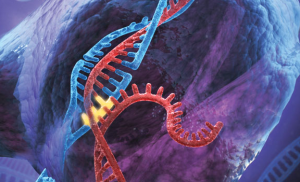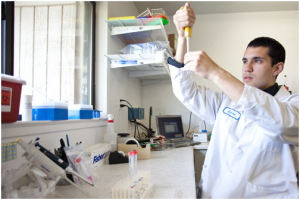 There is a large consorted effort in finding treatment options for diseases that stem from genetic aberrations such as mutations, DNA damage, and other heritable disorders. Treatment options for these disorders have been focused on alleviating the symptoms instead of curing them completely. Unlike other acute injuries or infections, genetic diseases often rely on novel, targeted long term treatment methods such as monoclonal antibodies or chemotherapy. A novel methodology that takes advantage of clustered regularly interspaced palindromic repeats (CRISPR) has garnished recent attention due to its potential to be used as a targeted approach to remove these faulty genes.
There is a large consorted effort in finding treatment options for diseases that stem from genetic aberrations such as mutations, DNA damage, and other heritable disorders. Treatment options for these disorders have been focused on alleviating the symptoms instead of curing them completely. Unlike other acute injuries or infections, genetic diseases often rely on novel, targeted long term treatment methods such as monoclonal antibodies or chemotherapy. A novel methodology that takes advantage of clustered regularly interspaced palindromic repeats (CRISPR) has garnished recent attention due to its potential to be used as a targeted approach to remove these faulty genes.
The CRISPR guidance RNA and associated CAS protein are normally used by bacteria to defend against viral invasion. Normally, viral genetic materialare recognized by Cas1 and Cas2 which acquire fragments of the viral genetic material and incorporates them into the CRISPR array in the bacterial genome allowing a faster defensive response for the next encounter. Recently, a CRISPR system has been modified for better targeting of mammalian genes; a human optimized version of the Cas9 protein that localizes to mammalian cell nuclei was made as well as a complex consisting of CRISPR guidance RNAs targeting various loci associated with human diseases. Genome editing can then occur by delivering Cas9 and the associated guidance RNA into the target cells.
One major advantage of using CRISPR as a future genetic therapy is that it is relatively easy to use. Compared to other gene editing applications such as the zinc fingers or  the transcription activator-like effector nuclease (TALEN), which require synthetic proteins to carry out their function, CRISPR only requires the modification of the target sequence within the guidance RNA. In this case, tedious protein engineering work is not needed, speeding up the process of potential therapeutic development. The versatilility of this system allows the targeting of many different sites for potential therapeutic treatment for cancer and other heritable diseases such as cystic fibrosis, sickle cell anemia, and Huntington’s disease among others. So far scientists have generated around 190,000 targetable sequences for approximately 40.5% of the exons in the human genome. Genomic sequencing with technological support to carry out Next Generation Sequencing library preparation efficiently, are currently providing a way to generate more targetable sequences on a consistent basis.
the transcription activator-like effector nuclease (TALEN), which require synthetic proteins to carry out their function, CRISPR only requires the modification of the target sequence within the guidance RNA. In this case, tedious protein engineering work is not needed, speeding up the process of potential therapeutic development. The versatilility of this system allows the targeting of many different sites for potential therapeutic treatment for cancer and other heritable diseases such as cystic fibrosis, sickle cell anemia, and Huntington’s disease among others. So far scientists have generated around 190,000 targetable sequences for approximately 40.5% of the exons in the human genome. Genomic sequencing with technological support to carry out Next Generation Sequencing library preparation efficiently, are currently providing a way to generate more targetable sequences on a consistent basis.
Currently, two biotechnology companies have been working extensively on transferring CRISPR system into therapeutic use. Since all the spotlights are on the CRISPR system, more and more resources will be devoted to the application development. In the near future, cancer and other chronic disorders could potentially be solved by utilizing this bacterial defensive mechanism. Now that is pretty exciting eh?


